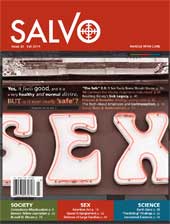Science: Deprogram


Article originally appeared in
Salvo 30
In recent columns, I have addressed the change in worldview that follows from assuming that information, not matter, is the basic stuff of life. Life differs from non-life principally by its enormous level of information. Efforts to understand life as if information were an accidental byproduct of matter are hitting a hard, opaque ceiling. There is simply no real progress on such matters as, say, the origin of life, the origin of the human race or the human mind, or even the origin of many groups of animals.
What have we learned so far?
1. Information is created by ruling out possibilities.
2. But information relationships are not causal. The existence of information does not cause us to know or accept it—so information is different from, say, gravity, but just as real.
3. Information (for example, the formula for a life-saving medicine) can be stripped of all matter and transmitted by a variety of means (voice, mail, phone, fax, e-mail, Morse code, smoke signals) across material nature, to produce an effect.
4. Information, while not causal, is connective. That is, the connections, rather than the information itself, cause actions or events.
5. From an informational realist point of view, nature could be material or more than material. Or it could consist entirely of immaterial information relationships. At this point, we don't know. We can't know, because we are wedded to materialism as a doctrine of scientific progress, whatever the evidence.
6. A life form's communications network needs at least three material elements: (i) information senders and receivers, (ii) physical transmission media, and (iii) filtering devices; and at least three non-material elements: (i) a grammatical language like the genetic code, understood by both the sender and the receiver, (ii) information to transmit, which is neither matter nor energy but is inherently conceptual—for example, "This environment is too hot"—and (iii) meaning and purpose. "Too hot" means something to a living creature because the creature seeks to maintain its existence (purpose). The information itself is not the cause of the creature's moving away from the hot spot; its search for survival is.
On this view, life can be imagined as a search for solutions to the problems of staying alive. For that matter, evolution can be conceived of as a species' search for a niche for survival.
A Bolder Idea
But the informational realist perspective, espoused by information theorist William Dembski in his new book Being as Communion (Ashgate, 2014), unpacks another, bolder idea, the Law of Conservation of Information (CoI). This law states that natural causes can transmit complex specified information, but they can never originate it. If the idea is correct, it means that the current purely natural (material) theory of evolution is not even possible.
Here is a brief statement: Raising the probability of success of a search does nothing to make attaining the target easier, and may in fact make it more difficult, once the informational costs involved in raising the probability of success are taken into account. (Being, 168).
If this sound counterintuitive, consider: suppose you have absolutely no information about how to find the hidden prize in a treasure hunt. You could start a search for a correct method of search (essentially, a search for a search). But in the absence of hints or cheating, that will turn out to be as much trouble as just doing an organized blind search.
Of course, a kindly person might come along and say, "As it happens, I know where the prize is. You are now just slightly warm . . . warmer . . . getting hot . . . HOT!!" So you get the prize, but you did it by making use of an intelligent source of information. On a blind search, you would still be looking. For that matter, if you had depended on a false source of information, whose intention was to mislead you, you would be much worse off, because you would be systematically steered away from the prize. Intelligence can either inform or mislead.
Ramifications for Darwinism
Dembski did not invent the underlying idea of conservation of information. Biologist Peter Medawar (1980s) and computer scientist Tom English (1996) advanced the view that information is not created from scratch but rather is redistributed from existing sources. Robert Marks II and his students at Baylor University in Texas have developed the idea in terms of "search," and their approach has profound consequences for plausible ideas of how evolution occurs, especially when vast claims are made for WEASEL and other "evolution" computer programs. As we will see in Part II, they are smuggling in information in order to arrive at their target.
What this means for Darwinian evolution versus intelligent design is that unintelligent causes (i.e., blind search mechanisms) cannot produce the rare, information-rich sequences we see in life. An intelligent cause must point the search function in the right direction in order to produce functional information in life within a viable period. Life forms do not have indefinite amounts of time to solve their problems; sometimes they have only a few seconds, and at most a few generations.
And the best that the naturalist can come up with at that point is to suggest that there could be a multiverse out there in which all possibilities are in fact realized. So probability calculations in this frame of reference mean nothing—we are an incidental winner among an infinity of losers we can never know anything about and whose existence we must accept on faith because naturalism and Darwinism are true.
Curiously, it is the Utilitarian philosopher John Stuart Mill (1806–1873), a very challenged theist at best, whose "method of difference" explains why naturalistic evolution, including those "evolution" computer programs, can't possibly work the way many believe. •
Next: Naturalistic evolution and the method of difference.
If you enjoyed this article from Salvo magazine, please consider contributing to our matching grant fundraising effort. All gifts will be matched dollar for dollar! Thanks for your continued support.
 |
 |
 |
© 2014 Salvo magazine. Published by The Fellowship of St. James. All rights reserved.
Forgot password?
Close message
Subscribe to this blog post's comments through...
Subscribe via email
SubscribeComments (2)
Sort by: Date Rating Last Activity
Tom_English 2p · 1 week ago
If samplers have no information about the samples they draw, then how do we account for the fact that sampler ("search") A is more likely than sampler B to select a sample that includes at least one element of the target (to "hit the target")? There is not the least mystery here. Samplers differ in their biases. That is the gist of why I was wrong to indicate in 1996 that information somehow resides in samplers, and why Dembski and Marks are wrong to do so today.
The following includes a technical correction of my own errors, but ends with exposition that should make sense to everyone who is able to follow you:
http://boundedtheoretics.blogspot.com/2014/08/sam...
The errors of Dembski and Marks apparently derive from a misunderstanding of the "no free lunch" theorem for search. The following links to an interview in which Marks attempts to explain the theorem in layperson's terms, and provides an accessible discussion of how he goes awry:
http://boundedtheoretics.blogspot.com/2012/04/bob...
Tom_English 2p · 1 week ago
Comments by IntenseDebate
Reply as a Guest, or login: